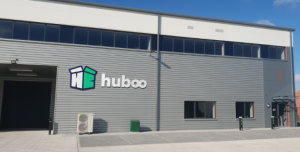Last summer, a secretive space company took up residence in a massive warehouse in the sun-soaked industrial neighborhood that surrounds Long Beach Airport. Reflections of turboprop panes flit across the building’s mirrored panes. Across the street a retro McDonnell Douglas sign perches above the aerospace giant’s former factory, and just around the corner Virgin Orbit is developing air-launched rockets.
It’s a fitting headquarters for SpinLaunch, a company breathing new life into the decades-old idea of using giant mechanical slings to hurl rockets into orbit. The man behind this audacious plan is the serial entrepreneur Jonathan Yaney. For years he ran SpinLaunch out of a former microprocessor plant in Silicon Valley, down the road from Google. Now the company is ready to open a proper rocket factory, where it will churn out launch vehicles and, if all goes well, take its first steps into the cosmos.
When I visited this past fall, SpinLaunch employees were still unpacking from the move. As we walked among giant sheets of steel, Yaney explained how his launcher will work. A centrifuge large enough to contain a football field will whip a rocket around in circles for roughly an hour, its speed steadily ramping up to more than 5,000 mph. The vehicle and its payload—up to 200 pounds’ worth of satellite—will experience forces that, at their peak, will be ten thousand times stronger than gravity. Once it’s spinning at launch speed, the centrifuge will release the rocket and send it screaming into the stratosphere. At the threshold of the cosmos, it will fire its engine for a final nudge into orbit.
The idea that an object weighing thousands of pounds can punch its way into space after spinning in circles on Earth’s surface can be hard to fathom. It might even sound crazy, and the company has a lot to prove to shake its critics. So far it has managed to spin an 11-pound dummy payload at more than 4,000 mph and send it crashing into a steel wall. Between those tests and the edge of space, however, are roughly a hundred miles and a whole lot of air resistance. Never mind the engineering work needed to build a centrifuge 100 yards wide, with an arm strong enough to support a roughly SUV-sized rocket.
Yaney hopes this is the year he achieves vindication. The company plans to conduct its first suborbital launches this winter at a new test site in New Mexico. Assuming the system works, Spinlaunch promises to reduce the cost of sending small satellites into space by a factor of almost 20. But the bigger deal may be its launch cadence. Yaney predicts the mass accelerator will be able to do five launches a day; most rocket companies can’t do that many launches in a month. In the era of mega-satellite constellations, which will see thousands of small satellites sent to low Earth orbit over the next decade, Yaney believes Spinlaunch’s time has come.
Four Million Bucks and a Crazy Idea
Like so many space entrepreneurs, Yaney has been obsessed with the cosmos all his life. But it took until 2014 for him to try to turn his passion into a career. He was working at Titan Aerospace, a solar-powered drone startup founded by his brother Maximus, when Google decided to acquire it. As he contemplated what to do next, Yaney’s mind turned again and again to a Cold War military project called HARP, in which the United States Army used a giant gun to shoot projectiles into space. HARP proved it was possible to get to space without a rocket, so Yaney set out to build a kinetic launch system of his own. He cobbled together a working proof of concept, essentially a motorized sling that could spin a bullet-sized projectile up to hypersonic speeds. He took it to a few angel investors and secured a small amount of funding.
But he needed help. In late 2014 he called up his old roommate from boarding school, Ryan Hampton, a whiz at construction and industrial operations. Hampton was running underwater welding operations on oil rigs in the Gulf of Mexico when Yaney made his pitch. As Hampton recalls, “He said, ‘I’ve got 4 million bucks and a crazy idea, want to come with me?’”
Hampton couldn’t resist. In January 2015 he flew out to see what Yaney had built. It wasn’t much. Yaney showed off his tabletop centrifuge and shared his spreadsheets full of calculations. But Hampton was hooked: He saw that SpinLaunch was “gonna be one hell of a project,” and signed on as employee number one.
Yaney had the ideas and Hampton the construction skills, but they still needed some aerospace engineers. So on a warm spring day a few months later, the pair climbed into Yaney’s Cessna and flew out to the edge of the Mojave desert, where dozens of college students had gathered to test their rockets. The duo was hoping to recruit a few of them.
One of their targets was David Wrenn, a junior at San Diego State University. He had been doing phone interviews with SpinLaunch for weeks, and the circumstances weren’t ideal for an in-person interview. “I had been awake for like 36 hours at that point, so I was semi-insane when I met Jonathan,” Wrenn recalls. Still, the meeting went well. He took a leave of absence from college and flew out to San Francisco to join SpinLaunch, where he now works as a senior mechanical engineer.
Hampton says the early days of SpinLaunch reminded him a lot of life on an oil rig. Employees lived and worked at an old microprocessor plant SpinLaunch had taken over just down the road from the Googleplex. When Wrenn arrived, the living spaces were spare. “At that point the kitchen was like a microwave and a plastic table,” he says. “You had to have a lot of vision or nothing to lose, one or the other.” When they weren’t working, the SpinLaunch crew lifted weights together in a makeshift gym, watched movies in a “home theater,” or relaxed around a fire pit—the converted remnants of Yaney’s original tabletop centrifuge.
The team quickly ran into engineering challenges. The centrifuge they were building had to sit in a massive vacuum chamber to protect the system from air turbulence and stabilize it as it spun. When they approached contractors to build the chamber, they got one bid—with a price of $20 million.
So the SpinLaunch team decided to build it themselves. As an underwater welder, Hampton had become an expert at crafting airtight seals, which translated well to his new task. Yaney ordered a few vacuum pumps off of eBay and $500,000 worth of steel, and the team set out to build the sixth-largest vacuum chamber, by diameter, in the world. It took them eight months. “I think we all began to realize that there are so many things in science and engineering that have to be uncovered, simply because people don’t try them,” Yaney says.
In 2016 they completed their first centrifuge. At 40 feet in diameter, it’s still too small to hoist a rocket into space, but the fundamental design is the same. A long arm, called a tether, stretches out from an oil-slicked bearing powered by a motor. The payload attaches to the end of the tether. To withstand the enormous strain it will experience, the tether will have to be made of ultrastrong materials like Kevlar and carbon fiber.
After nearly two years of working 12 hours a day, six days a week, the SpinLaunch team was finally ready to fire up its first real centrifuge. “We were all huddled into a room about 50 feet away behind a bunch of monitors and cameras,” Yaney says. They checked that the system was in good shape, and then went for it. “We just hit the throttle and broke the world record for the fastest rotational system.”
Over the next few years, the team ran hundreds of high-speed tests. Most of them were to study and improve the system, but some were to mollify skeptical investors and potential customers who didn’t believe a payload could withstand the extreme forces. The team sent solar cells, radio systems, telescope lenses, batteries, GPS modules, and control computers whirling at high speeds; they all survived with little to no damage. In one test, Yaney attached an iPhone to the tether and spun it up to nearly 4,000 mph. Afterward, he used the phone to FaceTime a colleague. Each test was a step, however small, toward space.
SpinLaunch built its first 12-meter centrifuge prototype at its former headquarters in Sunnyvale.
Courtesy of SpinLaunchThe Worst Rocket Ever Made
In the center of SpinLaunch’s cavernous warehouse, Yaney approached an object and pulled back its protective tarp. This, he proudly said, was “the worst rocket ever made.”
About 25 feet long and solid black with a shiny silver tip, the rocket’s briolette shape looks bulky compared to the lithe, arrowlike forms of a typical rocket. In general, only a tiny part of a rocket’s mass can be its payload; most of the rest is its fuel. That’s why companies like SpaceX need a rocket as big as a building to carry a satellite the size of a car. In aerospace circles, this is known as the “tyranny of the rocket equation.”
But, as Yaney realized, if you can spirit a rocket to the edge of space without having to carry all the fuel to get there, the rocket can be stocky and more of its mass can be dedicated to the payload. Even better, the rocket’s engine doesn’t have to be that good. Whereas a regular orbital-class rocket is engineered to squeeze every last drop of efficiency from its engines to maximize its payload capacity while breaking the chains of gravity, most of the hard work for SpinLaunch’s rocket is done by the centrifuge.
In SpinLaunch’s design, once a rocket is spinning at launch speeds, an exit port in the centrifuge will open for a fraction of a second, sending the rocket shooting out. According to patents filed by the company, a counterbalance spinning opposite the rocket gets released at the same time, preventing the tether from becoming unbalanced and vibrating into oblivion. The rocket coasts for about a minute and ignites its engines at roughly 200,000 feet. At that altitude, there’s hardly any atmosphere pushing against the rocket, so a minute-long engine burn is about all it takes to boost the vehicle to orbital speeds of around 17,500 mph. Another burn, this one lasting just 10 seconds, helps the rocket slide into orbit around Earth.
Engineers cluster around SpinLaunch’s first orbital rocket; a centrifuge is visible in the background.
Courtesy of SpinLaunchOr so Yaney assures me. When I visited the company, the prototype centrifuge was still in pieces and Yaney wouldn’t show me any videos of it in action. Instead, he insisted the math of SpinLaunch engineers was solid. Major investors—including Airbus Ventures, Kleiner Perkins, and GV (part of Alphabet)—have given their blessing too, pumping $80 million into the company. And last year, the US Department of Defense awarded SpinLaunch a contract to help develop its centrifuge. Still, the scant public evidence that any of it works leaves much to the imagination.
Juan Alonso, an aerospace engineer at Stanford who did due diligence for one of SpinLaunch’s investors, understood my reservations. “It’s an exotic technology, and the first time you hear about it you think there’s no way that could possibly work,” he says. But after checking out the math himself, Alonso gave the investment firm the green light.
Although SpinLaunch is reluctant to share many hard numbers, two patents granted to the company in 2018 and 2019 offer some insight into its incredible physics. When I presented these patents to a number of aerospace engineers from leading research universities, however, most of them expressed skepticism.
The biggest critique voiced by these engineers had to do with the forces the rocket will endure in the centrifuge. While the rocket spins, it will experience forces more than 10,000 times stronger than gravity. A typical rocket only has to deal with forces about five to seven times gravity during its journey to space. “No rocket could survive this, nor could the electronics inside the rocket,” says Dan Erwin, an aerospace engineer at the University of Southern California.
One former employee, who spoke on condition of anonymity due to their nondisparagement and nondisclosure contracts, acknowledged the gulf between theory and reality. They described SpinLaunch’s prototype centrifuge as a relatively unsophisticated machine that “any average engineering team could put together.” The employee said that scaling up to a functional suborbital launcher is going to be “very challenging” with SpinLaunch’s resources. The employee also cited the inexperience of some of the leaders. “The foresight to predict many of the issues that are going to happen was definitely lacking,” they said.
Yaney has heard these criticisms before. He happens to see a lack of industry experience as an asset. “We’ve been putting together a team of engineers who, for the most part, are too young to say SpinLaunch couldn’t work,” he says. “They’re full of too much energy and excitement to find out what’s going to happen.”
As for the punishing forces, he points to the long history of launch vehicles that have weathered a journey to space similar to what a SpinLaunch vehicle will have to endure, including the US Army’s giant projectile-launching gun and modern guided munitions, which can handle forces thousands of times greater than gravity. Besides, he says his rocket will be more rugged than the average fragile launch vehicle—more like a missile than SpaceX’s Falcon 9.
As the iPhone demonstration attests, electronic components can survive the extreme forces during acceleration, though some more delicate electronics will need slight modifications. For example, the company has already filed patents for ruggedized solar panels and reaction wheels, which help satellites orient themselves.
“This isn’t something new that SpinLaunch is doing—we are simply following in the footsteps of previous work,” Yaney says. Later this year, he plans to prove it during the system’s first suborbital launch.
SpinLaunch employees inspect the interior of the company’s 12-meter prototype centrifuge.
Courtesy of SpinLaunchThe Long Road to Space
Physics isn’t the only obstacle in the company’s path. Ultimately, SpinLaunch will need a coastal launch site, so the rockets don’t pose a threat to civilians. Finding a suitable location has been harder than Yaney anticipated. In April 2018, Hampton and Raphael Feldman, a project manager, traveled to Hawaii to seek permission to build such a facility on the Big Island. At first, the state was supportive, even drafting a $25 million funding bill that would allow Hawaiians to invest in the company through government-backed bonds. But during a tense town hall meeting at the Naalehu Community Center on the Big Island, near the site SpinLaunch was after, residents barraged local government officials with accusations of corruption and concerns about how SpinLaunch’s operations would destroy local wildlife and pose a threat to islanders.
“If there is any chance that a site in the county is chosen for this fly-by-night, ill-begotten project, I’ll tell you where you can find me,” one resident said. “You can find me at the access gate where you paved over lava tubes and sacred grounds, and I will be attached to that gate with kryptonite locks and chains until you go away.”
The dismal town hall led to the collapse of the funding proposal, and SpinLaunch gave up on Hawaii. While the search for a coastal launch site continues, the company is building out a test site over land.
Last May, SpinLaunch broke ground at New Mexico’s Spaceport America, where it is now building a centrifuge three times larger than the one in Los Angeles. Yaney hopes they will conduct their first suborbital flight tests later this year, launching projectiles weighing about 110 pounds over the nearby White Sands Missile Range. The tests would represent a significant step up from the 11-pound payloads it has experimented with so far. For the past few months, Hampton and about two dozen other employees have lived near the spaceport in a makeshift company town made of shipping containers. There’s a jacuzzi, an archery range, and a virtual reality room—small perks to make living in the middle of the desert a little more tolerable.
Yaney says he is confident the system will perform as expected, and they’ll soon be ready to line up customers. A ride to space with SpinLaunch will cost under $500,000 per launch, and Yaney says he is only looking to work with companies that want to launch dozens if not hundreds of satellites.
Launching even one into orbit would be a major achievement. The history of private launch companies is largely a history of failure, but like some space-age Sisyphus, Yaney seems to embrace the struggle. Space exploration demands the boldness to venture into the unknown, and in SpinLaunch’s case, the unknown is vast. The payoff, however, is nothing less than opening a new door to the cosmos.
Updated 1-29-20, 10am EST: This story was updated to reflect that both the satellite and rocket experience the force from acceleration.
More Great WIRED Stories
- The iPad at 10: A look back at its first decade
- He wanted a unicorn. He got … a sustainable business
- What Atlanta can teach tech about cultivating black talent
- The science behind crafting a perfect espresso
- The future of death tech has no rules—yet
- 👁 The secret history of facial recognition. Plus, the latest news on AI
- 💻 Upgrade your work game with our Gear team’s favorite laptops, keyboards, typing alternatives, and noise-canceling headphones



